In an era defined by the pervasive nature of global media, the concept of “Traveling Images” has become increasingly relevant. Berlin-based artist and filmmaker Hito Steyerl delves into this phenomenon in her work, particularly highlighted in her 2007 essay “Documentary Uncertainty.” Steyerl examines the paradox within contemporary documentary filmmaking, where some works lean towards “authoritative truth procedures” reminiscent of institutional settings, while others succumb to a postmodern relativism, blurring the lines between fact and misinformation. This duality is crucial in understanding how politics in our time often thrives on misinformation, making the reinvention of documentary practice not just urgent but also complex. Steyerl’s unique background, marked by her insightful writings on postcolonialism, globalization, and feminism alongside her innovative film and video work, positions her perfectly for this endeavor.
Steyerl’s journey into filmmaking began in her teens in Germany, influenced by the New German Cinema movement. Her formal education in film extended to Japan and later Munich, where she studied under Helmut Färber and worked with Wim Wenders. Her influences range from Harun Farocki to Marguerite Duras, and Jacques Rancière’s perspective on documentary forms as distributions of the sensible resonates deeply with her approach. For Steyerl, documentary filmmaking is not just about historical reference but also about a profound consideration of video’s formal organization, acknowledging the uncertain status of truth in our contemporary world.
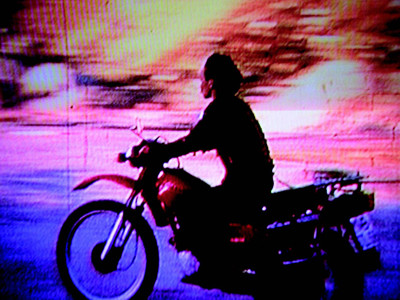 Hito Steyerl, *November*, 2004, still from a color video, 25 minutes.November (2004), showcasing her exploration of traveling images and documentary uncertainty through color video.
Hito Steyerl, *November*, 2004, still from a color video, 25 minutes.November (2004), showcasing her exploration of traveling images and documentary uncertainty through color video.
The Erratic Journey of Images in November (2004)
Steyerl’s video November (2004) vividly illustrates her approach to “traveling images” through the multifaceted life—or rather, the circulating images—of Andrea Wolf, a German/Kurdish figure. The video culminates in a powerful segment that showcases the unsettling fluidity between fact and fiction surrounding Wolf’s life and the film’s construction. We see a clip from an early feminist martial arts film by Steyerl featuring Wolf as a biker-jacketed heroine. This image then transforms into Wolf’s persona as Şehît Ronahî, a Kurdish revolutionary fighter reportedly killed in 1998 during conflict with the Turkish army. Her image, displayed on placards during Kurdish protests in Germany, became a symbol of Kurdish resistance. Steyerl then merges this martyr image back into the celluloid fighter, adding layers of meaning. This blending reflects the disputed claims by the Turkish government that Ronahî might still be alive, operating underground. As Steyerl’s narration points out, Andrea transformed into a “traveling image,” globally disseminated and reproduced via various media.
Wolf’s transformation into a “traveling image” encapsulates the core theme of November. The video situates itself within a historical context marked by unaccountable government power, fragmented political struggles, and representational instability. Steyerl reinforces these political undertones by including a segment from Sergei Eisenstein’s October (1927), drawing a contrast between the revolutionary solidarity envisioned in October and the disjointed, disempowered political landscape reflected in November’s flux of signs. This flux mirrors interconnected markets but reveals political struggles as scattered and ineffective. In November, the heroes of the past become disillusioned figures, reflecting a world where truth is fragile, identity is uncertain, and protest is vulnerable to corruption.
 Michael Asher, no title, 2008. Installation view, Santa Monica Museum of Art, California. Photo: Grant Mudford.
Michael Asher, no title, 2008. Installation view, Santa Monica Museum of Art, California. Photo: Grant Mudford.
However, November also identifies possibilities within this uncertainty. While acknowledging the lost revolutionary potential of October, Steyerl utilizes cinematic tools to their fullest. The video employs narration and a dynamic montage of popular culture imagery as a form of humorous, real-life rallying cry. These include clips from Russ Meyer’s Faster, Pussycat! Kill! Kill! (1965) and Bruce Lee’s unfinished film. The latter’s plot of staged death and real death mirrors the continuous mutations of Ronahî’s image. Furthermore, Steyerl includes her own experience of being turned into a “Kurdish protester” for television, illustrating how easily images, even of the filmmaker, can be co-opted and misrepresented within the media landscape. This personal anecdote emphasizes the film’s central idea: “we are all part of the story, and not I am telling the story, but the story tells me.”
To counter the elusiveness of “traveling images,” November employs self-reflexive techniques. Shots of a blinding film projector light appear during a witness account of Ronahî’s death, and close-ups of grainy TV screens replay footage from videotapes. These moments serve as a critical strategy of appropriation, reminiscent of modernist techniques. Steyerl’s montage echoes works like Alexander Kluge’s Deutschland im Herbst (Germany in Autumn, 1978). Yet, unlike Eisenstein’s montage intended to spark insight or Kluge’s gaps for viewer imagination, Steyerl’s video confronts the dissolution of distinct filmic elements within the digital age’s fluctuating image economy and power networks.
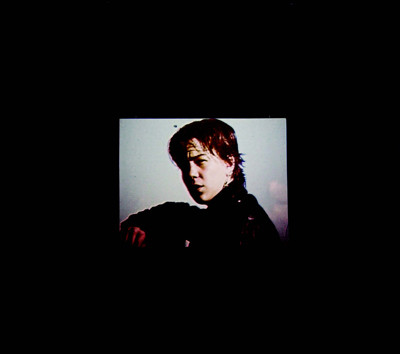 Hito Steyerl, *November*, 2004, color video. Installation view, Signal Gallery, Malmö, Sweden, 2006. Photo: Terje Östing/Signal.November (2004) at Signal Gallery, Malmö, Sweden in 2006, emphasizing the immersive experience of her exploration of image travel and transformation.
Hito Steyerl, *November*, 2004, color video. Installation view, Signal Gallery, Malmö, Sweden, 2006. Photo: Terje Östing/Signal.November (2004) at Signal Gallery, Malmö, Sweden in 2006, emphasizing the immersive experience of her exploration of image travel and transformation.
Documentary Uncertainty and the Exhaustion of Subversion
November clarifies that a simple return to the revolutionary ideals of October is untenable. When depicting Ronahî’s martial arts use in Kurdistan, Steyerl incorporates scenes from René Viénet’s Can Dialectics Break Bricks? (1973), a Situationist critique disguised as a martial arts film. This inclusion suggests that avant-garde methods of subversion, from Eisenstein’s montage to Situationist détournement, are now exhausted. In this context, traditional documentary strategies might appear futile. Steyerl’s innovative conclusion is that documentary film’s defining characteristic is its “uncertainty.” This uncertainty, she argues, is not a flaw but the core quality of contemporary documentary modes. The revitalization of the video essay, with its renewed focus on historical and political consciousness, must begin by embracing this inherent uncertainty.
Unstable Spaces and Shifting Politics in Die leere Mitte (1998)
Steyerl’s earlier film, Die leere Mitte (The Empty Center, 1998), further explores “documentary uncertainty,” focusing on unstable spaces—geographic, cinematic, mythic, and mnemonic. This 16mm film examines Berlin’s central area between Potsdamer Platz and the Reichstag as a site of evolving cultural politics. Steyerl intertwines historical accounts of xenophobia faced by Felix Mendelssohn and his grandfather Moses Mendelssohn with the tragic story of Mohammed Hussein, a WWI veteran who died amid Nazi racism, and the contemporary amnesia of reunified Germany. The film uses slow dissolves and visual palimpsests to emphasize the fluidity of borders, superimposing footage of a former customs gateway over Felix Mendelssohn’s drawing of his house. This technique reveals persistent patterns of community formation based on exclusion, even in reunified Berlin where new, invisible boundaries replace physical ones. An interview with a young Asian man highlights the ongoing experience of being a “non-German,” indicating that unification has not benefited “outsiders.” The film connects economic insecurity and scapegoating of foreigners to past racist violence, underscoring how historical amnesia leads to the re-emergence of disturbing patterns.
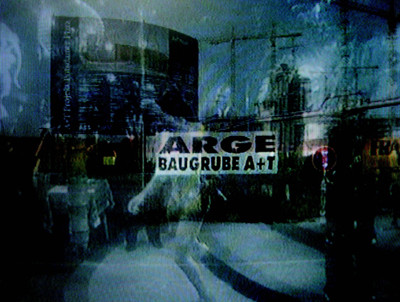 Hito Steyerl, *Die leere Mitte* (The Empty Center), 1998, still from a color film in 16 mm, 62 minutes.Die leere Mitte (The Empty Center) (1998), illustrating her early engagement with “documentary uncertainty” through 16mm film and exploration of unstable geographic and cultural spaces.
Hito Steyerl, *Die leere Mitte* (The Empty Center), 1998, still from a color film in 16 mm, 62 minutes.Die leere Mitte (The Empty Center) (1998), illustrating her early engagement with “documentary uncertainty” through 16mm film and exploration of unstable geographic and cultural spaces.
Die leere Mitte doesn’t present its historical narratives as absolute truths. Instead, it acknowledges its subjective construction through Steyerl’s personal voice-over, devoid of traditional authoritative sourcing. This approach transforms the nature of “truth.” Drawing on Jacques Rancière’s analysis of Chris Marker’s essay films, Steyerl’s work reverses the conventional documentary practice of treating reality as a fact to be understood. Instead, documentary becomes a mode of fiction, blending “real” (indexical footage) and “fabulated” (constructed narrative) elements. Rancière terms this blend “documentary fiction,” where imagery—archival documents, cartoons, live footage, narration—radically alters the real vs. representation dichotomy. In this “documentary fiction,” thoughts and things merge, blurring the sensible and the intelligible.
This genre redefines fiction as “to forge” rather than “to feign,” and documentary loses its reliance on factual evidence. Steyerl’s documentaries engage the audience actively, inviting them to be both engrossed in the story and aware of the multiplicity of representations. Die leere Mitte opens up Berlin as a site of ongoing struggles, urging viewers to engage with its profound contradictions. The film concludes with Siegfried Kracauer’s hopeful words: “There are always holes in the wall we can slip through and the unexpected can sneak in.” The squatters in the former “death strip” between East and West Berlin symbolize ideal viewers who participate in shaping Berlin’s future.
Reclaiming Personal History in Lovely Andrea (2007)
In Lovely Andrea (2007), Steyerl further explores “traveling images” through a personal quest to reclaim a “traveling image” from her past. The video chronicles her search for a lost photograph of herself in nawa shibari style bondage, taken during her film school days in Japan in 1987. Twenty years later, with no memory of the photographer or studio, she embarks on the daunting task of finding one image among thousands. This search takes her through Tokyo, accompanied by her translator and cameraman. Documentary footage and interviews are interwoven with appropriations from cartoons and pop music videos, reflecting the commodification and circulation of images, particularly of women.
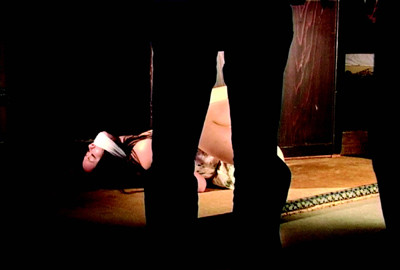 Hito Steyerl, *Lovely Andrea*, 2007, still from a color video, 30 minutes.Lovely Andrea (2007), capturing her personal quest for a “traveling image” and her exploration of image circulation in the context of personal and cultural history.
Hito Steyerl, *Lovely Andrea*, 2007, still from a color video, 30 minutes.Lovely Andrea (2007), capturing her personal quest for a “traveling image” and her exploration of image circulation in the context of personal and cultural history.
Clips from Spider-Man cartoons in Lovely Andrea amplify themes of networks and suspension, driving the video’s quick pace, energized by handheld camera work. This rapid delivery mirrors the accelerated culture industry and MTV’s style, reflecting Steyerl’s interest in Japanese avant-garde cinema and filmmakers like Hara Kazuo. Steyerl’s search evolves into a sociological investigation of sexual domination, shame, and the connection between pain and visual pleasure. The video includes diverse references to bondage in samurai arts, WWII torture, and contemporary military practices, underscoring its ubiquity. Despite the potential degradation, the video also explores the complexities of agency and pleasure within these practices.
Steyerl eventually finds her image in a pornographic magazine library, titled “Lovely Andrea,” a pseudonym borrowed from Andrea Wolf. A significant revelation is that Asagi Ageha, Steyerl’s translator, is also a bondage model. The video concludes with Ageha performing self-suspension, embodying erotic charge and self-agency. Ageha’s control over her image within a system of domination positions her as an unexpected heroine. This parallels Steyerl’s reappropriation of her lost image, reframed within the video essay. Steyerl’s act of reappropriation becomes a form of defiance against copyright and control within a culture of easy reproduction. Her commitment to low-resolution images, resulting from multiple copies, reinforces the degraded link between sign and referent. This act of historical retrieval becomes decontextualization and decay, once again throwing documentary representation into uncertainty, but this time, productively, revealing a space for political mobility and subjective liberation.
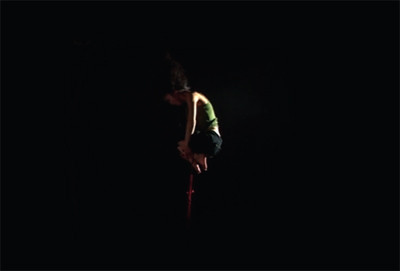 Hito Steyerl, *Lovely Andrea*, 2007, still from a color video, 30 minutes.Lovely Andrea (2007), emphasizing the themes of personal image reclamation and the complex interplay of agency and representation in “traveling images”.
Hito Steyerl, *Lovely Andrea*, 2007, still from a color video, 30 minutes.Lovely Andrea (2007), emphasizing the themes of personal image reclamation and the complex interplay of agency and representation in “traveling images”.
Abstraction and Political Stakes in Red Alert (2007)
Steyerl’s Red Alert (2007) takes the demise of representation to an extreme. Displayed at Documenta 12, it features three screens showing the same red monochrome image, representing the “outer limit” of documentary video where image reduces to static color and abstraction. The red mimics the US Department of Homeland Security’s terror alert color, and its multiplication signifies the global spread and normalization of such warning systems. The piece also references Aleksandr Rodchenko’s 1921 primary colors triptych, declaring the end of traditional painting. Red Alert expands on November’s lament: red, once a revolutionary symbol, now triggers mediatized fear, where affective image surpasses representational meaning.
Red Alert critiques the system where representation becomes reductive, akin to pornography, stripping signs of complexity. This system’s prevalence connects to the erosion of political representation and the rise of executive power and deregulation, paralleling increased migration and statelessness. By linking political disenfranchisement with representational denudation, Red Alert condemns the state and mass media’s abstract language. It challenges documentary’s supposed transparency and exposes the political stakes of this challenge by imbuing abstraction with political and art-historical significance.
Conclusion: Uncertainty as a Catalyst for Political Engagement
Steyerl acknowledges that “documentary uncertainty” might be insufficient for today’s political needs. She suggests replacing the current fear-based “economy of affect” with a new one, though admitting this new constellation is yet to emerge fully. However, her practice itself points a way forward. In an age where images are inherently “traveling images,” embracing uncertainty allows for a revitalized engagement with history, language, body, sexuality, social communities, and urban space. Steyerl’s documentaries not only highlight the urgency of these goals but also begin to construct the “affective and political constellation” needed to achieve them. In Steyerl’s vision, the inevitable journey of images becomes an opportunity for transformation and political action.
T. J. Demos is a lecturer in the Department of Art History, University College London.
NOTES
- Hito Steyerl, “Documentary Uncertainty,” A Prior 15 (2007), 306 and 304.
- Ibid., 306.
- In November, Steyerl also points out the way in which fictional film has determined real-life actions, including the testimony of German radicals who actually employed methods of kidnapping they learned from films such as Gillo Pontecorvo’s Battle of Algiers (1966) and Costa-Gavras’s State of Siege (1972).
- Not surprisingly, Steyerl’s discussion of documentary “uncertainty” also bears similarity to Gilles Deleuze’s notion of the cinematic image, which dissolves the distinction between the real and the imaginary. See Gilles Deleuze, Cinema 2: The Time-Image (1985), trans. Hugh Tomlinson and Robert Galeta (Minneapolis: University of Minnesota Press, 1989). This text also informs Jacques Rancière’s discussion in Film Fables (see below).
- Steyerl, “Documentary Uncertainty,” 304. Steyerl’s new book, Die Farbe der Wahrheit (The Color of Truth) (Vienna: Turia & Kant, 2008), promises to expand this analysis.
- Jacques Rancière, Film Fables (2001), trans. Emiliano Battista (New York: Berg, 2006), 158–159.
- Rancière, Film Fables, 2–3.
- Steyerl, “Documentary Uncertainty,” 308.

